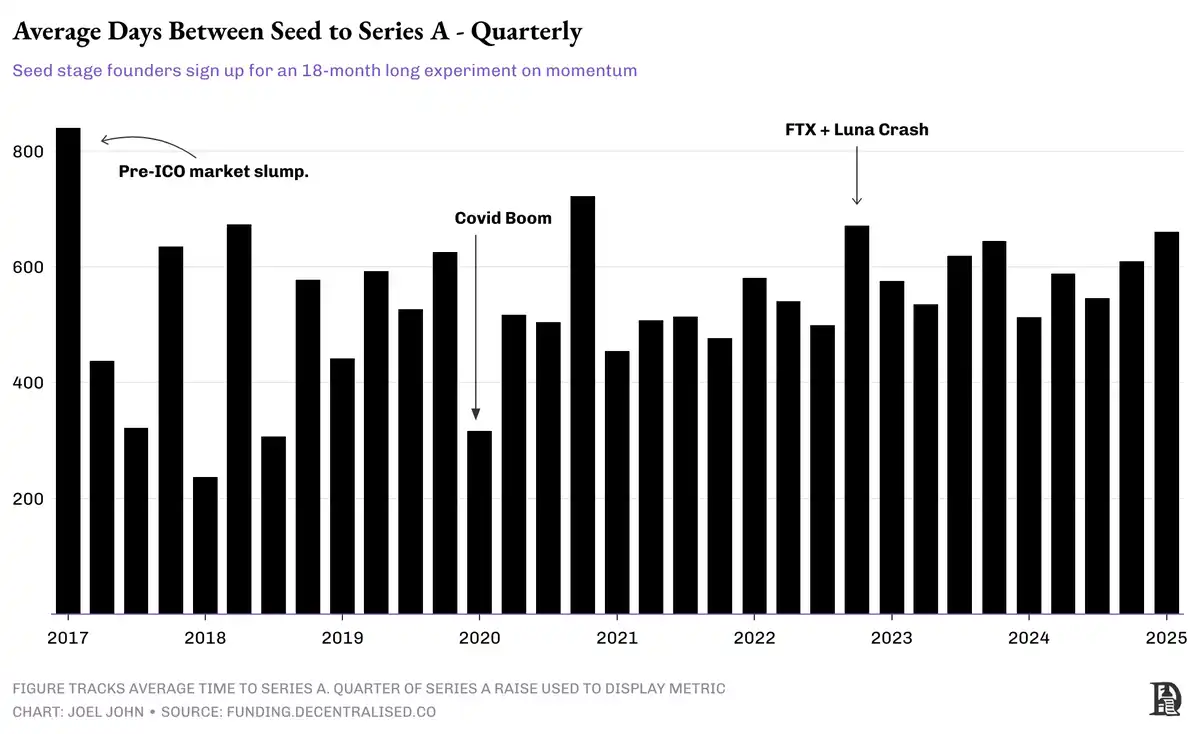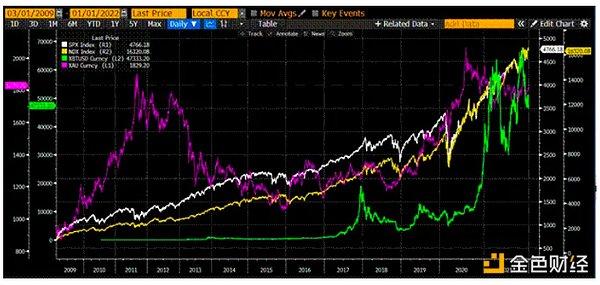Over the past few years, the scale of early-stage Web3 financing has expanded, but funds have been concentrated among a few companies, making fundraising more difficult. After the FTX collapse, LP funds gathered around a few leading funds, making it even harder for startups to secure financing. Token liquidity has decreased, investment return cycles have lengthened, and the market is now more focused on profitability and product-market fit. Venture capital will not disappear, as Web3 infrastructure has matured and AI development brings new opportunities. In the future, capital will favor founders with long-term competitive advantages rather than short-term token gains. The key question is which founders and investors can persist to the end and find the ultimate answer to industry evolution. This article is sourced from Decentralised's article, compiled, translated, and written by zhouzhou,
BlockBeats.
(Previous context:
MircoStrategy Restarts "Buy Buy Buy" Mode? Comprehensive Analysis of New Financing Plan)
(Background supplement:
Deep Dive into Asia-Pacific DePIN: "Why Is Everyone Choosing Solana", Reviewing 8 Major Projects, Financing, and Investment Growth Potential)
Web3 Financing Status in the First Quarter of 2025
A rational market participant might believe that capital has its ups and downs, like many things in nature, with cyclical characteristics. However, venture capital in the crypto field is more like a one-way waterfall - a continuous experiment about gravity.
We may be witnessing the final stage of a frenzy that began with the smart contract and ICO wave in 2017, accelerated during the low-interest environment of the COVID-19 period, and is now returning to a more stable level.
At the peak in 2022, venture capital in the crypto field reached $23 billion. By 2024, this figure had plummeted to $6 billion. The main reasons for this decline are threefold:
1. The 2022 frenzy led to excessive fund inflow - venture capital invested in many products like DeFi and Non-Fungible Tokens at extremely high valuations in a seasonal market, ultimately failing to deliver expected returns. OpenSea was once valued at $13 billion, representing the market bubble's peak.
2. Difficult fund-raising and disappearing valuation premiums - Many funds faced obstacles in fundraising during 2023/2024. Projects that successfully listed on exchanges struggled to reproduce the high valuation premiums of 2017-2022. Due to the lack of valuation increases, funds found it challenging to raise new capital, especially when many investors' returns underperformed Bitcoin.
3. AI replaced crypto as the "next big thing" - Large capital institutions shifted their attention to AI, causing crypto to lose its speculative fervor and premium as the "most promising frontier technology".
However, the deeper issue is that very few startups truly grow to Series C or D. Some might argue that the primary exit method in the crypto industry is token exchange listing, but when most tokens are listed at a loss, investors' exit becomes difficult. This is particularly evident when comparing data across different financing rounds.
Since 2017, out of 7,650 companies that received seed funding, only 1,317 successfully entered Series A, with a progression rate of 17%. Of these, 344 advanced to Series B, with only about 1% (±1%) reaching Series C. The probability of reaching Series D is merely 1/200, comparable to other industries in @Crunchbase's statistics. However, the crypto industry has a unique situation: many growth-stage companies bypass traditional financing paths through tokenization. This reveals two core issues:
- Without a healthy token liquidity market, crypto venture capital will stagnate. This gap will be filled by liquidity market participants like @SplitCapital and @DeFianceCapital.
- If insufficient companies grow to later stages and successfully go public, investors' risk appetite will decrease.
Looking at data from various financing stages, the market is sending the same signal: While seed and Series A capital inflows remain basically stable, active investments in Series B and C have significantly decreased. Does this mean it's a good time for seed funding? Not necessarily. The key lies in the details.
The data below shows the median funding amounts for pre-seed and seed rounds per quarter. We can observe an overall upward trend. Two points are worth noting:
- Pre-seed funding amounts have grown significantly since early 2024.
- The nature of seed funding has changed over the past few years.
We've observed that despite decreased early-stage capital investment willingness, the scale of pre-seed and seed funding for startups has actually increased. The previous "friends and family round" is now filled by early-stage funds, a trend that also affects seed funding. Since 2022, seed funding scale has expanded to address rising labor costs and the longer time needed to achieve product-market fit in the crypto industry. However, the decrease in product development costs has somewhat offset this trend.
The increase in funding amounts means higher valuations (or equity dilution) at early stages, which also means future valuations need to grow more to provide returns for investors. Additionally, funding scale showed a notable increase in the months following Trump's election. This might be related to changes in the fundraising environment for fund management partners (GP) after Trump took office - with increased interest from funds of funds (FoF) and traditional allocators, pushing the early market into a "risk appetite" mode.
What does this mean for founders? Currently, early-stage Web3 financing funds are more abundant than ever before, but funds are concentrated among fewer founders, with larger financing scales and demands for faster company growth compared to previous cycles.
As traditional liquidity channels (such as token issuance) are drying up, founders need to invest more effort in demonstrating their credibility and the potential of their business. The era of "50% discount, high-valuation financing within two weeks" has passed. Funds can no longer profit by "raising valuations," founders cannot easily raise funds, and employees' vested tokens no longer enjoy rapid appreciation bonuses.
One perspective to verify this trend is capital velocity. The chart below shows the average time startups experience from seed round to Series A. Lower values mean faster capital velocity, indicating investors are willing to invest more capital at higher valuations in seed-stage companies before they mature.
Another key factor is how public market liquidity affects the private market. Investors often increase private market investments when public market returns decline. For example, during Q1 2018, when the market experienced a sharp drop, Series A financing significantly decreased. A similar situation occurred in Q1 2020 during the COVID-19 market crash. For investors with capital, the attractiveness of private market investments increases when public market opportunities diminish.

In Q4 2022, after FTX's collapse, market risk appetite dramatically decreased. Unlike previous market downturns where private market financing increased, this collapse directly destroyed the crypto industry's attractiveness as an asset class. Previously, several large funds had invested substantial capital in FTX's $32 billion valuation financing, ultimately losing everything. Consequently, investor interest in the entire industry significantly declined.
After FTX's collapse, capital began concentrating in a few leading companies, becoming "kingmakers" that dominated capital flows. Most Limited Partners (LPs) channeled funds into top-tier funds, which preferred deploying capital in later-stage projects to absorb more capital. In other words, startup financing environments became more challenging.
The Future of Crypto Venture Capital?
Over the past six years, I've observed these data, consistently concluding that startup financing would become increasingly difficult. At 24, I might not have realized the industry's evolutionary pattern. Market euphoria attracts talent and capital, but as the industry matures, financing difficulty inevitably rises. In 2018, projects could raise funds simply by being "on the blockchain"; by 2025, investors focus more on profitability and product-market fit (PMF).
With decreasing token liquidity, venture capitalists must reassess liquidity and capital deployment strategies. Previously, investors expected token returns within 18-24 months; now, this cycle has extended. Employees must work harder to obtain the same token quantity, which often trades at lower valuations. This doesn't mean the industry lacks profitable companies, but like traditional economics, ultimately only a few companies will absorb most economic value.
Will venture capital disappear? From a joking pessimistic perspective, perhaps. But reality is that Web3 still needs risk capital.
- Infrastructure layers have matured to support large-scale consumer applications.
- Founders have experienced multiple market cycles, gaining deeper industry understanding.
- Internet coverage continues expanding, with global bandwidth costs declining.
- AI development is expanding Web3 application possibilities.
These factors collectively constitute an unprecedented opportunity period. If the venture capital industry wants to "make venture capital great again," they must focus on founders themselves, not token issuance. Today, capital allocators are more willing to spend time supporting founders with potential to dominate markets. This change represents Web3 investors' growth from 2018's "When will we issue tokens?" to 2025's "What are the market's limits?"







